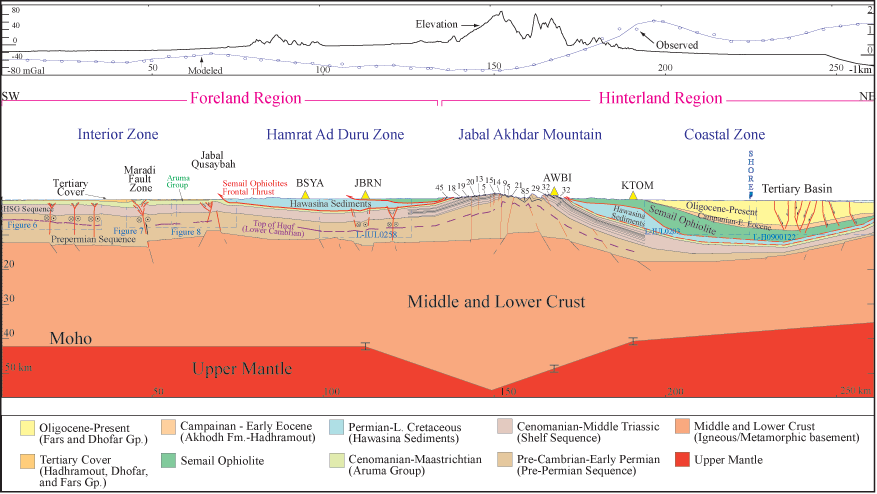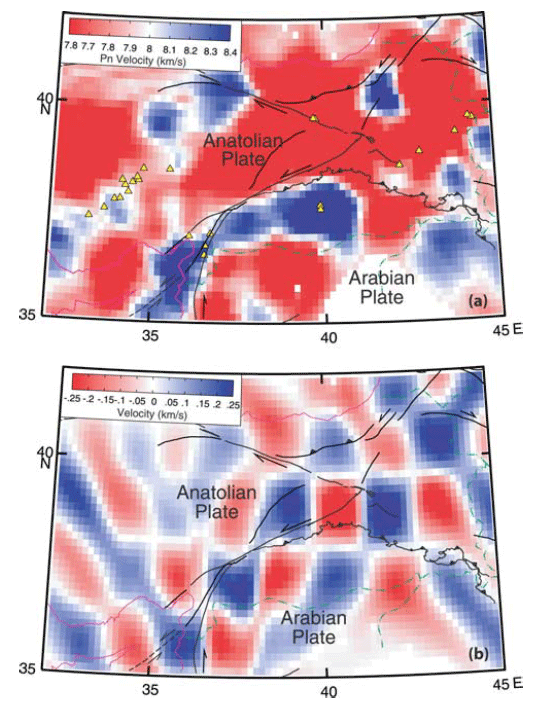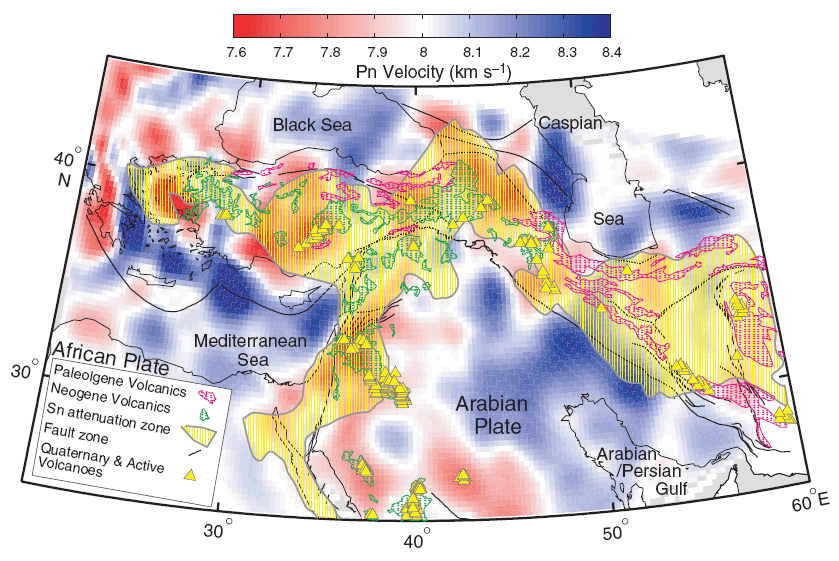
This dissertation focuses on studying the crustal structure on the southeast margin and foreland of Arabia in Oman, and upper mantle rheology and structure at the zone of interaction between the Arabian, Eurasian, and African plates (Figure 1.1). At the center of the study area, the Arabian plate is bounded in the east by the Indian plate along the Owen and Murray Transform Fault zones, in the northeast and north it is bounded by the Eurasian plate along the ZagrosBitlis Suture zones, and in the west, northwest, and southwest it is bounded by the African plate along the Dead Sea Fault, the Red Sea, and the Gulf of Aden (Figure 1.1). Northwest of Arabia, the Hellenic and the Cyprean arcs define the convergence boundary between the African plate and the Anatolian plate in eastern Mediterranean Sea (Figure 1.1).
One of the most important events throughout geologic history of the region is the closure of the NeoTethys ocean. It began in Early Cretaceous along the eastern and northeastern boundaries of the Arabian-Africa Plate and lasted to Pliocene times (Sengor and Yilmaz, 1981). Ophiolite emplacement is a process that commonly accompanied the closure and subduction of the NeoTethys ocean. At present day a belt of NeoTethyan ophiolites follows the suture zone between the Arabian-Eurasian plate boundary and farther west within the Anatolian plate (Figure 1.1). While at the north and northeast boundaries of the Arabian plate the closure of the NeoTethys and final suturing processes have concluded and resulted in the building of the Iranian-Anaoltian plateaus, at the southeast Arabian plate boundary, a piece of the NeoTethys oceanic lithosphere (Semail Ophiolites) was emplaced in the late Cretaceous, but the closure process is still ongoing by subducting the remnant basin of Oman at the Makran Subduction zone (Figure 1.1).
At a later stage, the opening of the Red Sea and Gulf of Aden is thought to have occurred episodically (Hempton, 1987). An initial phase occurring in the period Middle-Late Eocene and a later phase occurred in the Early Pliocene (~14.5 Ma) (Hempton, 1987). This separation of Arabia from Africa accommodated by the left lateral Dead Sea Fault System is thought to be responsible for the reorganization of relative plate motions in the Anatolian Plateau (Eurasian plate) (Sengor and Yilmaz, 1981). In early Pliocene, continued N-S convergence between Arabia and Eurasia resulted in the extrusion of an Anatolian plate along the North Anatolian Fault (NAF) and the East Anatolian Fault (EAF) zones (Bozkurt, 2001). The Anatolian plate's westward escape is converging along the Hellenic and Cyprean subduction zones, where Africa's oceanic lithosphere is being subducted.
Chapter two of this dissertation presents a detailed study of the crustal structure
along 255 km long transect that includes the hinterland, the mountains, and
the foreland of Oman. The main objective of this study is to investigate the
crustalscale structure of the eastern Arabian margin, across the 3,000 meters
high Oman Mountains. Various geophysical and geological data are used to model
the crustal thickness along the transect. We used exploration seismic and well
data to constrain the upper 78 km of the sedimentary column, receiver function
to infer Moho depth along the transect, and gravity modeling to constrain Moho
lateral variations and infer a basement depths along the transect. Furthermore,
integrated geological and geophysical data shed valuable information about the
processes that accompanied the Semail Ophiolite emplacement.
Chapter three focuses on the young continent-continent collision zone between northern Arabia and Eurasia along the Bitlis-Zagros Suture zone. We use Pn tomography to further our knowledge about the mantle lithosphere rheology and structure and its contribution to lithosphere dynamics at the young Bitlis-Zagros continent-continent collision zone. Pn velocities higher than 8 km/s are used to infer stable mantle lid, while Pn velocities less than 8 km/s are used to infer mantle lid instability. Chapter four presents evidence on upper mantle rheology using Pn velocity and structure and using Pn anisotropy at the junction of the Arabian, Eurasian, and African plates. This research looks at the larger scale picture of the three plates' interactions and use Pn velocity and anisotropy to contrast regions underlain by stable mantle lid from those unstable and to investigate uppermost mantle processes. This study, also, focuses on regions underlain by small scale (< 200 km) very low Pn velocity anomalies that indicate thinned to absent mantle lid. This study compares Pn velocity with Sn attenuation map of the region. It also compares observed Pn azimuthal anisotropy with shear wave SKS polarization anisotropy to infer asthenospheric mantle deformation.
Click here to view a PDF of the complete dissertation
Figure 2.16.
The complete transect of the crust and parts of the upper mantle from the interior of Oman in the southwest, across the Jabal Akhdar Mountain and in the hinterland in the northeast. Also, shown observed and model Bouguer gravity values, with the corresponding elevation along the transect. The transect depicts important stratigraphic sequences and formations, and structural relations. Red lines indicate faults and black arrows indicate relative motion along the fault. 2-D seismic profiles location along the transect are indicated by dashed blue and green rectangles. The Semail Ophiolites frontal thrust is delineated at the sole of the Hawasina Sediments, and a bold red line indicates the sole of the igneous ophiolite body. Dip information of the Jabal Akhdar Mountain are shown along the surface of the structure. The transect also shows locations of deployed seismic stations (yellow triangles) and the corresponding, projected, impinging locations are shown as error bars. (See also, Al-Lazki et al., 2002)

Figure 3.3.
(a) A map showing our tomographic image of Pn velocity using only the data picked and read by the authors. The upper bounds of high Pn velocity zone along the EAF and the eastern BS are used to define the northern extent of the Arabian plate boundary. (b) A map showing 1.5° x1.5° checkerboard test results inverted using the same stations and events distribution for Figure 3a. The best resolution is along the EAF, eastern BS zones, and at the intersection zone between the EAF and NAF zones. Symbols are as in Figure 3.2 (see dissertation). (See also: Al-Lazki et al., 2003)

Figure 4.12.
A comparative map showing Pn velocity with anisotropy (base map, red-blue color, see Figure 4.7a in dissertation), volcanic outcrops in green and pink polygons filled withplus signs, Sn attenuation zones in yellow lines hatched areas enclosed by a solid gray line (after Khaled Al Damegh, personal communication, June 2002), and volcanoes in yellow triangles. (See Figure 4.1 in dissertation for geographic locations). (See also: Al-Lazki et al., 2004)
